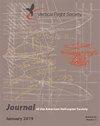地面效应下全尺寸直升机尾流不稳定性和梢涡系统
IF 1.4
4区 工程技术
Q2 ENGINEERING, AEROSPACE
引用次数: 2
摘要
对自由飞行的德国航空航天中心试验直升机空中客车Bo105和EC135在悬停、垂直起飞和前飞过程中的地面效应进行了研究。高速纹影系统以每转约60个图像的速度跟踪叶尖涡流。此外,恒温风速测量系统利用纤维膜传感器阵列,提供转子流中的速度统计和光谱。总体尾流结构与之前的研究一致,但速度剖面和叶尖涡流轨迹对环境风条件敏感。在纹影图像中观察到尖端涡流,直到转子平面下方约两转的年龄,然后才出现不稳定性并降至检测极限以下。Bo105发现了系统涡流配对,但EC135没有。通过转子谐波速度信号,在尾流下游发现了叶尖涡流的残余,但与具有类似Kolmogorov谱的宽带湍流波动相比,它们的作用很小。对于垂直起飞情况,旋翼尾流具有类似悬停的结构,直到超过约1.4旋翼半径的轮毂高度时分解为低频振荡。在前向飞行中,根据归一化的推进比对不同类型的尾流速度足迹进行了分类。在主旋翼平面的前部区域以及主旋翼叶尖涡流和Bo105尾旋翼之间发现了叶片-涡流的相互作用。相互作用阻止了叶尖涡流的进一步发展。本文章由计算机程序翻译,如有差异,请以英文原文为准。
Wake Unsteadiness and Tip Vortex System of Full-Scale Helicopters in Ground Effect
The main rotor wakes of the free-flying DLR test helicopters Airbus Bo105 and EC135 were investigated in ground effect during hover, vertical takeoff, and forward flight. A high-speed schlieren system tracked the blade tip vortices at about 60 images per revolution. In addition, a constant temperature anemometry system utilized arrays of fiber film sensors, providing velocity statistics and spectra in the rotor flow. The overall wake structure agreed to preceding studies, but the velocity profiles and tip vortex trajectories were sensitive towards the environmental wind conditions. The tip vortices were observed in the schlieren images up to an age corresponding to about two revolutions below the rotor plane, before developing instabilities and falling below the detection limit. Systematic vortex pairing was found for the Bo105 but not for the EC135. The remnants of the tip vortices were identified further downstream in the wake by means of rotor-harmonic velocity signals, but they play a minor role in comparison to broad-banded turbulent fluctuations with a Kolmogorov-like spectrum. For vertical takeoff cases, the rotor wake had a hover-like structure until breaking down into low-frequency oscillations when exceeding a hub height of approximately 1.4 rotor radii. In forward flight, different types of wake velocity footprints were categorized on the basis of the normalized advance ratio. Blade–vortex interactions were found in the frontal area of the main rotor planes and between the main rotor tip vortices and the Bo105's tail rotor. The interactions prevent a further evolution of the tip vortices.
求助全文
通过发布文献求助,成功后即可免费获取论文全文。
去求助
来源期刊

Journal of the American Helicopter Society
工程技术-工程:宇航
CiteScore
4.10
自引率
33.30%
发文量
36
审稿时长
>12 weeks
期刊介绍:
The Journal of the American Helicopter Society is a peer-reviewed technical journal published quarterly (January, April, July and October) by AHS — The Vertical Flight Society. It is the world''s only scientific journal dedicated to vertical flight technology and is available in print and online.
The Journal publishes original technical papers dealing with theory and practice of vertical flight. The Journal seeks to foster the exchange of significant new ideas and information about helicopters and V/STOL aircraft. The scope of the Journal covers the full range of research, analysis, design, manufacturing, test, operations, and support. A constantly growing list of specialty areas is included within that scope. These range from the classical specialties like aerodynamic, dynamics and structures to more recent priorities such as acoustics, materials and signature reduction and to operational issues such as design criteria, safety and reliability. (Note: semi- and nontechnical articles of more general interest reporting current events or experiences should be sent to the VFS magazine
 求助内容:
求助内容: 应助结果提醒方式:
应助结果提醒方式:


